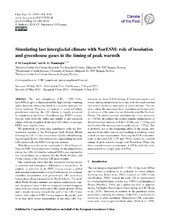| dc.contributor.author | Langebroek, Petra | eng |
| dc.contributor.author | Nisancioglu, Kerim Hestnes | eng |
| dc.date.accessioned | 2015-09-03T11:29:05Z | |
| dc.date.available | 2015-09-03T11:29:05Z | |
| dc.date.issued | 2014-07-10 | |
| dc.identifier.issn | 1814-9332 | en_US |
| dc.identifier.issn | 1814-9324 | en_US |
| dc.identifier.uri | https://hdl.handle.net/1956/10385 | |
| dc.description.abstract | The last interglacial (LIG, ~130–116 ka, ka = 1000 yr ago) is characterized by high-latitude warming and is therefore often considered as a possible analogue for future warming. However, in contrast to predicted future greenhouse warming, the LIG climate is largely governed by variations in insolation. Greenhouse gas (GHG) concentrations were relatively stable and similar to pre-industrial values, with the exception of the early LIG when, on average, GHGs were slightly lower. We performed six time-slice simulations with the low-resolution version of the Norwegian Earth System Model covering the LIG. In four simulations only the orbital forcing was changed. In two other simulations, representing the early LIG, additionally the GHG forcing was reduced. With these simulations we investigate (1) the different effects of GHG versus insolation forcing on the temperatures during the LIG; (2) whether reduced GHGs can explain the low temperatures reconstructed for the North Atlantic; and (3) the timing of the observed LIG peak warmth. Our simulations show that the insolation forcing results in seasonal and hemispheric differences in temperature. In contrast, a reduction in the GHG forcing causes a global and seasonal-independent cooling. Furthermore, we compare modelled temperatures with proxy-based LIG sea-surface temperatures along a transect in the North Atlantic. The modelled North Atlantic summer sea-surface temperatures capture the general trend of the reconstructed summer temperatures, with low values in the early LIG, a peak around 125 ka, and a steady decrease towards the end of the LIG. Simulations with reduced GHG forcing improve the model–data fit as they show lower temperatures in the early LIG. Furthermore we show that the timing of maximum summer and winter surface temperatures is in line with the local summer and winter insolation maximum at most latitudes. Two regions where the maximum local insolation and temperature do not occur at the same time are Antarctica and the Southern Ocean. The austral summer insolation has a late maximum at ~115 ka. In contrast the austral summer temperatures in Antarctica show maxima at both ~130 ka and ~115 ka, and the Southern Ocean temperatures peak only at ~130 ka. This is probably due to the integrating effect of the ocean, storing heat from other seasons and resulting in relatively warm austral summer temperatures. Reducing the GHG concentrations in the early LIG (125 and 130 ka) results in a similar timing of peak warmth, except over Antarctica. There, the lower austral summer temperatures at 130 ka shift the maximum warmth to a single peak at 115 ka. | en_US |
| dc.language.iso | eng | eng |
| dc.publisher | Copernicus Publications | en_US |
| dc.rights | Attribution CC BY | eng |
| dc.rights.uri | http://creativecommons.org/licenses/by/3.0/ | eng |
| dc.title | Simulating last interglacial climate with NorESM: role of insolation and greenhouse gases in the timing of peak warmth | en_US |
| dc.type | Peer reviewed | |
| dc.type | Journal article | |
| dc.date.updated | 2015-07-28T08:46:30Z | |
| dc.description.version | publishedVersion | en_US |
| dc.rights.holder | Copyright 2014 The Authors | en_US |
| dc.identifier.doi | https://doi.org/10.5194/cp-10-1305-2014 | |
| dc.identifier.cristin | 1143759 | |
| dc.source.journal | Climate of the Past | |
| dc.source.40 | 10 | |
| dc.source.14 | 4 | |
| dc.source.pagenumber | 1305-1318 | |
| dc.relation.project | Norges forskningsråd: 221598 | |
| dc.subject.nsi | VDP::Matematikk og naturvitenskap: 400::Geofag: 450::Meteorologi: 453 | |
| dc.subject.nsi | VDP::Mathematics and natural scienses: 400::Geosciences: 450::Meteorology: 453 | |

